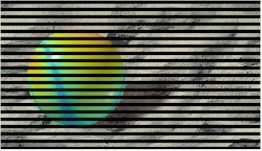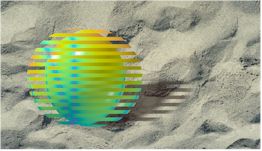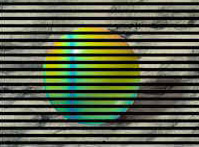
720 > 1080
Proposal: 1080I Should Be Renamed 540I - and 480I Should Be Renamed 240I

|
|
To be fair: 1440P = 720/60 P |
||
|
720 lines |
720 lines |
|
|
 |
 |
 |
 |
 |
 |
 |
 |
|
540 lines |
540 lines |
|
|
|
Or: 540I = 540/60 I |
|||
|
|
 |
|
This depicts how progressive (P) scanning works - see top row - versus how interlaced (I) scanning works - bottom row. People (such as Congressmen) read "our" 720P proposal and "their" 1080I proposal and assume that 1080I is superior because the number is larger. The diagram above shows that this is a fallacy. In the progressive system, 720 lines are presented to the human eye every 1/60th of a second while the so-called 1080I system presents only 540 lines. Therefore a more accurate name for the interlaced system is 540I. It also more accurately represents the fact that the interlaced system is lower in quality than our 720P system. Not only is 720P superior to 540I in quality (note the well-known artifact: interlace flickers), but it is cheaper! And it is naturally compatible with computers (which all use progressive scanning). Now you can understand the title of this page: It is 720P that is greater than 540I - formerly known in old-speak as 1080I.
We Progressives (vs Them, the Interlacers) could have inflated our number to 1440P using the same logic as the interlaced camp (add together the two numbers from two successive 1/60th second intervals). But this is just not right. Our system delivers 720 lines at each instant; theirs 540. Scanline number escalation is not an answer. Hence the proposal is to lower the number in the offending name.
Notice two things:
Our 480P system looks good compared to 540I. 480 is just not that much less than 540. Yet Congressmen yell at the broadcasters, threatening their digital spectrum, when told of plans to broadcast 480P. I have seen 480P and it is wonderful. In fact, I have seen it side-by-side with 720P and 540I (well, 1080I, if you insist) systems, and 480P looks better! I am not the only one for whom this phenomenon holds. The reason: We humans react to increased brightness more than we do to increased resolution. The so-called "high-definition" television displays suffer from inability to deliver high brightness compared with 480P displays (I'm going to have to change this sentence once the digital mirror displays become popular - they ARE bright at all resolutions). Let no Congressman jump on broadcasters until he or she has seen side-by-side comparisons - with price tags attached. 480P is affordable; 540I is not - by either broadcasters or consumers. Expense delays return of the analog channels to Congress. And, of course, 540I is incompatible with computers and can't be used to read text. Here's the picture:
|
480 lines |
480 lines |
480P = 480/60 P |
|
 |
 |
 |
 |
 |
 |
 |
 |
|
540 lines |
540 lines |
|
|
|
540I = 540/60 I |
|||
|
|
 |
|
Current digital television (seen only in studios, sometimes referred to as "D1") has been called 480I up until now. By the renaming proposal above, it should be called 240I instead, for more fair comparisons. So a 480P system is much, much better than today's digital television, which is interlaced and has only 4:3 aspect ratio (vs 16:9), and of course only 240 lines per 1/60th second. (And, of course, today's digital television is much, much better than the analog that consumers see in their homes. ) This is another case where looking only at the numbers, ignoring the suffix P or I, is unfair to the Progressives. Here is a picture of the situation, to make the need for renumbering clearer:
|
480 lines |
480 lines |
480P = 480/60 P |
|
 |
 |
 |
 |
 |
 |
 |
 |
|
240 lines |
240 lines |
|
|
|
240I = 240/60 I |
|||
|
|
 |
|
Finally, all of the above arguments omit a very important consideration: The consumer sees compressed versions of any of the proposed formats. Nobody demonstrates the quality loss inherent in compression to Congressmen or consumers (or even to themselves). The "high definition" formats, 540I (aka 1080I) and 720P, have to be compressed by about 50:1 to fit them in the alloted digital channel. Yes, that's right: Compressed to 1/50th their original size (as seen in the production studio, say)! But 480P has to be compressed by the much smaller 18:1. And 240I (current digital TV, "D1"), has to be compressed by only 9:1. The point is: After compression - which is required for broadcast - the differences between formats even out. 480P and 240I are much better fits to the allotted channels. This is another reason they are so affordable. Consumers will be blown away by them. Again, a plea to Congressmen: Please insist on seeing comparisons of all the systems after compression before making demands on broadcasters.
Interlacers often claim that their system has more pixels. See bandwidths for the actual numbers. Summary: It is not the pixels in a still frame that counts - still video is boring. It is the pixels per second delivered to viewers that matters. The 540I system, as defined, delivers only slightly more pixels per second than 720P, and, as practiced, it delivers less! This, of course, is before compression. As argued above, what matters to consumers is after compression. After compression, the formats are indistinguishable so far as pixel count is concerned. However, the interlaced system is fundamentally flawed because of its flickering, which does not go away during compression.
CAUTION! When comparing systems, be sure you are watching a true comparison. If you are not, then what you are really comparing is the equipment used for format conversion, not the display technology. This seems obvious but I have seen many "comparisons" in the chat rooms, emails, websites, etc, where, for example, crummy source material displayed on a wonderful display system is "compared" with material originated in the format designed for a competing display technology. The crummy material still looks crummy. What a surprise! In a true comparison, the originating technology must be specified and all conversions that have been made to the material before display must be specified. Does the following work for a "comparison"?: Take material originated in 1080i (aka 540i) and (1) display it on a 1080i monitor; (2) convert it to 720p with a format converter; (3) display the converted material on a 720p monitor against the display in step (1)? Not a valid comparison! Step (2) will cause a degeneration (it has to because material has been thrown away for interlace - namely every other line) that no converter, except one costing about $100,000, can possibly compensate for well. So this "test" would be comparing a good version of the source material to a bad version. It would be testing the quality of the converter, not the display technologies. Another mistake I see is comparing low-res material upconverted to high-res against (originally) high-res material. Not a chance that the upconverted stuff will look as good. Again, this is comparing converters, not display technologies.
What about full-frame capture?: It has been suggested that full-frame capture - now being easy and widespread in devices - alters the argument above. If full-frame capture is done every 1/60th second and the appropriate field extracted and encoded in 1080i format (aka 540i), then the spatial tearing described above still happens of course (and one field of every captured frame is wasted). If however, full-frame capture is done every 1/30th second with the first field being used as the first field of 1080i and the second field being used as the second field of 1080i, then the spatial tearing described above does not happen BUT temporal tearing does happen, and the 1080i format is invalidly used. This is because the second field, instead of being sampled during the second 1/60th second of a frame time is sampled during the first 1/60th second and simply delayed 1/60th of a second. So the second field sample occurs at the wrong time. It doesn't fit the 1080i definition. The second field is skewed backward in time relative the first field, and this is what is meant by "temporal tearing." Of course none of this funny business is present in progressive scan systems. They simply grab full frames every 1/60th second and deliver them to the progressive format every 1/60th second, per definition of the format.